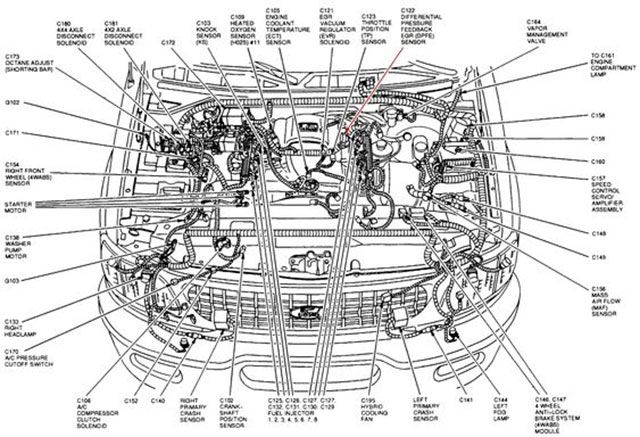If you have not explored engines extensively, you might be bewildered by the array of components under the hood. While some, like the battery, are recognizable to those with limited mechanical knowledge, many remain shrouded in mystery. The vacuum hose, in particular, can be quite elusive, especially when it comes to the Ford Triton 5.4 V8 engine. Its location isn’t immediately prominent, but we’re here to provide guidance to help you pinpoint it. Have a Triton Ford 5.4 vacuum hose diagram handy, and let’s start.
A few words about The Triton Ford 5.4-liter V8 Engine
The Triton Ford 5.4-liter V8 engine finds its place within the Ford Modular engine family, encompassing overhead cam V8 and V10 engines. The term “modular” signifies the manufacturing flexibility to swiftly reconfigure tooling for producing different engines within this family.
In its initial debut in 1997, the Triton 5.4 powered Ford F-series trucks like the F-150s. Over time, it extended its presence to E-series vans. While it continued its role in E-series vans, it ceased to be used in F-series trucks after 2010.
Notably, there exists a range of versions of this engine, including a supercharged iteration for the Ford Shelby Mustang. This high-performance powerhouse delivers an impressive 550 horsepower with 510 lb-ft of torque.

Table of Contents
What is the Triton Ford 5.4 Vacuum hose diagram?
A vacuum hose, also known as a “line” or “tube,” serves as a flexible rubber conduit, directing manifold vacuum to various components and accessories within the vehicle. The diagram shows the exact location of the vacuum hose and other tubes. These tubes are essential for powering a range of systems, from vacuum brake boosters to windshield wiper motors, and a vehicle can have numerous such hoses. To optimize the routing of the vacuum, connectors like vacuum tees, trees, valves, and other accessories are employed. These hoses vary in size, with the smallest having a 3/16″ inner diameter (ID) and the largest being 5/8″ ID hoses, primarily supplying manifold vacuum to brake boosters. While adapters are available for ID conversion, it is generally recommended to use appropriately sized vacuum hoses when replacing them.
What is the function of vacuum hoses?
Vacuum hoses have been integral to engine design since the late 1900s, and their importance endures in modern engines. They play a crucial role in the functioning of the internal combustion engine, contributing to vehicle safety and ease of control. Various components, such as brake boosters, windshield wipers, power steering, EGR valves, heater valves, HVAC controls, and more, rely on vacuum functions. Before the advent of power steering, driving was more challenging, and without brake boosters, slowing down was tougher. Vacuum hoses have successfully addressed these concerns, enhancing safety and driving comfort.
What is the shape of a Vacuum Hose in Tirton Ford?
The vacuum hose often resembles a J-shaped tube, which connects to the vacuum manifold within the engine. Its specific placement varies depending on the type of transmission, overdrive or non-overdrive, in the engine.
Non-Overdrive Gearbox
For trucks or vans with a non-overdrive transmission, the vacuum hose connects to the right side of the engine bay on a vacuum manifold that resembles a large nut. You’ll spot a J-shaped rubber hose entering what appears like an oversized nut.
Overdrive Gearbox
In Triton 5.4 V8 engines with overdrive, the vacuum hose can be found between the hose assembly and the reservoir. Again, it takes the form of a J-shaped rubber hose.
What are the types of vacuum hoses?
The term “vacuum hose” encompasses all the flexible tubes responsible for transmitting vacuum within a vehicle. However, you might hear “vacuum line” or “vacuum tubing” in reference to smaller diameter hoses. Common inner diameters for vacuum hoses include:
- 1/16″ (2mm)
- 3/32″ (3mm)
- 1/8″ (4mm)
- 5/16″ (8mm)
- 3/8″ (9/10mm)
Apart from inner diameter, vacuum lines vary in materials. Most are crafted from rubber, suitable for general use. But, in high-heat conditions, silicone vacuum lines are a reliable alternative.
Can you drive with a broken or leaking vacuum hose?
Numerous engine components might continue to function even if they exhibit signs of failure, yet the vacuum hose is a critical one to avoid driving with. As previously mentioned, it plays a pivotal role in the functionality of both power steering and brake systems. While its failure might not completely eliminate your ability to steer and brake, it can significantly increase the difficulty of these tasks, potentially resulting in an accident. If you’re experiencing problems with power steering or brakes, it’s advisable to inspect the vacuum hose, as it could be the root cause.
How to find a spoiled vacuum hose?
Since the vacuum hose is essentially a rubber tube, it’s susceptible to wear and tear, sometimes requiring replacement. The vacuum hose might be partly responsible if you notice decreased engine efficiency. Identify symptoms indicating the need for replacement to prevent potential issues.
Manual check
After reviewing the preceding sections of this piece and the Triton Ford 5.5 vacuum hose diagram, you should now understand the vacuum hose’s location better. With this knowledge, proceed to raise the hood and initiate a thorough visual and tactile inspection of the hose in question.
Your objective is to identify evident signs of deterioration or damage, particularly along the hose’s length and at its connection points. Scratches, cracks, and unusual bulges in the rubber could serve as potential indicators of an existing air leak or one on the verge of emerging.
Keep in mind that the engine bay can subject rubber hoses to a demanding environment, exposing them to heat and contact with fluids like coolant, which may contribute to wear and tear. Furthermore, hoses may occasionally loosen and come into contact with other engine components.
Employ a vacuum detector
If you possess some mechanical know-how, you might consider conducting a test on the vacuum hose. To do this, employ a vacuum gauge, connecting it to the hose while it remains attached to the engine’s vacuum system. Start the engine for a brief period to obtain a vacuum strength reading within the range of 17 – 21 inches on the gauge, which signifies smooth idling. If the gauge records a measurement below 17 inches, there’s likely a vacuum hose leak, necessitating a replacement. Alternatively, there could be an obstruction, and while it may be cleared, it might have caused internal hose damage, warranting a replacement.
You might not have to replace the hose
Individuals with advanced mechanical expertise might be aware that it’s possible to circumvent the need for an entirely new hose by simply excising the damaged segment of the hose and rejoining it with elbow connectors. However, keep in mind that there are definite restrictions on how much you can trim before you deplete the hose’s available length.
What is the best way to swap a Triton Ford 5.4 Vacuum Hose?
Swapping out vacuum lines is a straightforward task, usually requiring minimal or no tools. These lines are secured via a “press fit” mechanism, where the inner diameter of the tube is slightly smaller than the outer diameter of the connecting nipple or port. Here are the essential steps for vacuum line replacement:
- Disconnect the hose from both the vacuum source and the accessory.
- Take note of their original connections.
- Measure the vacuum hose and its inner diameter (ID) without stretching.
- Acquire a replacement hose with a matching ID and cut it to the required length.
- Attach the new hose to both the vacuum source and the accessory.
During this procedure, you might encounter some challenges. For example, vacuum lines can occasionally get firmly attached to their ports. In such situations, it may be necessary to carefully slit the hose lengthwise using a box cutter and then remove it.
When replacing multiple hoses, consider expediting the process by removing all hoses, cutting new ones together, and then installing them. To begin, check the engine compartment for a Triton Ford 5.4 vacuum hose diagram, often found under the hood, on a strut tower, or on the radiator core support, ensuring proper reconnection.
Triton Ford 5.4 Vacuum Hose Diagram – FAQs
Can you point out the location of the vacuum hose connection?
When is it time to replace the vacuum hoses in a Triton Ford?
If one or more vacuum lines experience failure, we advise you to contemplate replacing all of them. Furthermore, replacing a vacuum line becomes a prudent choice when you observe apparent signs of cracking or detect leakage (often accompanied by an audible hissing sound).
What security measures should I adopt while installing a car vacuum hose?
Final Words
Locating vacuum hoses can sometimes be a bit challenging, but it’s crucial to know their placement since they are integral to various engine systems in our vehicles. A damaged vacuum hose can potentially affect the safety of our steering and braking systems.
In essence, a vacuum hose is typically a rubber pipe with a J-shaped configuration that connects to the car’s vacuum system. If you’re having trouble finding the hose, start by seeing the Triton Ford 5.4 vacuum hose diagram and identifying the location of your engine’s vacuum system. The hose is usually situated nearby, making it relatively easy to spot.













